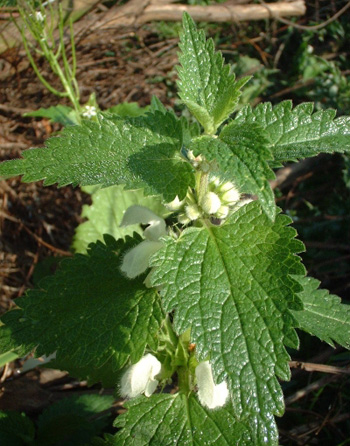Contents:
Common Names | Parts Usually Used | Plant(s) & Culture | Where Found | Medicinal Properties
Legends, Myths and Stories | Uses | Formulas or Dosages | Bibliography
Scientific Names

- Lamium album L.
- Nettle family
Common Names
- Dead nettle
- Nettle flowers
- Stingless nettle
- White archangel
- White dead-nettle
- White nettle
Parts Usually Used
Plant, flowers
Back to Top
Description of Plant(s) and
Culture
Blind nettle is a perennial plant; the hollow quadrangular stem is hairy, little-branched, and green or sometimes violet-hued. The leaves are opposite, petioled, ovate and cordate, hairy on both sides, and serrate. White bilabiate flowers appear from April to October.
Back to Top
Where Found
Found in gardens and waste grounds of New England, and in Europe along roadsides, hedges, fences, walls, railroad embankments, and thickets.
Back to Top
Medicinal Properties
Antispasmodic, astringent, expectorant, styptic
Back to Top
Legends, Myths and Stories
According to an old recipe book, steel dipped in the juice of this plant becomes flexible.
Back to Top
Uses
An infusion made from the plant is used for leucorrhea, irregular menstrual periods, and weak menstrual flow, stomach and intestinal problems, and vaginal douches. The infusion can be used as a bath additive to relieve uterine cramps, boils, and tumors. A poultice of boiled leaves and flowers can be used for tumors, boils, sores, varicose veins, and gouty pains. A tea or tincture made from the flowers is used for insomnia. Use young leaves in a salad for a spring tonic. Acts as astringent and is soothing with specific action on the reproductive system, reducing benign prostate enlargement and acting as a uterine tonic; useful after prostate surgery.
Back to Top
Formulas or Dosages
Infusion: use
Powder: take
Tincture:
Back to Top
Bibliography
![]() The Complete Medicinal Herbal
The Complete Medicinal Herbal, by Penelope Ody, Dorling Kindersley, Inc, 232 Madison Avenue, New York, NY 10016, First American Edition, copyright 1993
![]() Culpeper’s Complete Herbal & English Physician: Updated With 117 Modern Herbs
Culpeper’s Complete Herbal & English Physician: Updated With 117 Modern Herbs, by Nicholas Culpeper, Meyerbooks, publisher, PO Box 427, Glenwood, Illinois 60425, 1990, (reprint of 1814)
Herbal Gardening, compiled by The Robison York State Herb Garden, Cornell Plantations, Matthaei Botanical Gardens of the University of Michigan, University of California Botanical Garden, Berkeley., Pantheon Books, Knopf Publishing Group, New York, 1994, first edition
![]() Planetary Herbology
Planetary Herbology, by Michael Tierra, C.A., N.D., O.M.D., Lotus Press, PO Box 325, Twin Lakes. WI 53181., Copyright 1988, published 1992
![]() The Herb Book
The Herb Book, by John Lust, Bantam Books, 666 Fifth Avenue, New York, NY. copyright 1974.
